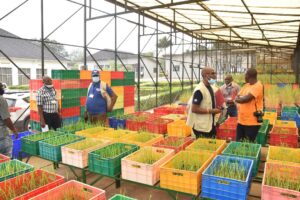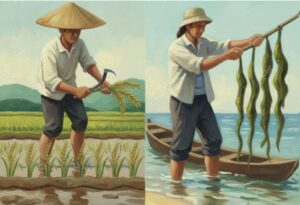by Mosharaf Hossain, Girija Prasad Swain, Subhasmita Mahapatra, and Swati Nayak
Binodini Swain’s story serves as an inspiring example for farmers in Odisha who leave their lands fallow instead of cultivating non-paddy crops. Using the knowledge to cultivate groundnuts using the recommended package of practices she learned, Mrs. Swain adopted a new diversified cropping system of rice followed by groundnuts. Her openness to new farming technologies has given her benefits beyond higher harvest and profits.

The inclusion of a new crop after the rice is harvested in the wet season is an established approach to intensify the cropping system and boost the productivity of agri-food systems in India. The best bundle of technology, a suitable rice variety, followed by a suitable non-paddy, leads to improved incomes from both crops and makes farming systems diversified, stable, and more resilient.
However, despite the positive impacts of such strategies, crop intensification, and diversification in eastern India, the practice has not caught on. Among the reasons for this are farmers possess limited knowledge about suitable crops and varieties to plant after rice and the absence of a robust seed system for non-paddy crops.
A housewife becomes a farmer
Binodini Swain’s story serves as an inspiring example for farmers in Odisha who leave their lands fallow instead of cultivating non-paddy crops. Mrs. Swain is a 52-year-old farmer from Ambapua Village in Belaguntha Block.
Because of poor health, her husband is not actively engaged in farming their modest landholding of 0.2 hectares (ha). Until 2022, the family didn’t engage in sharecropping either as their son sought daily wage jobs, leaving Mrs. Swain as the sole breadwinner. She supported the household by working as an agricultural laborer.
On their land, she typically cultivated paddy during the kharif season then allowed the land to remain fallow in the rabi season. Mrs. Swain and other farmers in the village commonly grew Swarna, a very popular rice variety. However, because Swarna is a long-duration (140 days) variety, the late harvest gave farmers a limited time to sow a second non-paddy crop for the rabi season. Swarna is also susceptible to diseases.
She previously grew green gram during the rabi season but discontinued this practice a few years ago. The choice to leave the land fallow is attributed to widespread open grazing and the intrusion of stray animals such as monkeys, deer, and parrots, a problem that has recently escalated. The scarcity of water, a problem shared by all farmers in her village, poses a significant challenge. Although the Chandibanda Minor Irrigation Project covers Ambapua, the facility was unutilized.
An integrated intervention
The Government of Odisha collaborated with the International Rice Research Institute (IRRI) to showcase and promote non-paddy crops for the dry season, particularly the groundnut in Ganjam District. Ganjam has one of the largest rice-growing areas—250,000 hectares—in Odisha.
To encourage the cultivation of non-paddy crops in the rice fallows IRRI adopted an integrated approach stipulated by the Odisha Integrated Irrigation Project for Climate Resilient Agriculture (OIIPCRA) Project. The approach included the development of a suitable crop calendar, the management of water resources, community-level training, as well as sensitization and mobilization efforts.
IRRI distributed the seeds of MTU-1224, a fine-grain variety of rice that can be harvested in 130 days allowing farmers to prepare the land for the next crop in the rabi season. The farmers liked the grain type and quality of MTU-1224, which had the added advantage of being less susceptible to diseases.
Unlike Swarna, which produced 4.25 tons a hectare, MTU-1224 yielded 4.75 tons/ha, resulting in an additional yield of 0.5 tons/ha. Farmers milled MTU-1224 on their own, thus leading to cost savings. Effectively, Swarna fetched USD 904/ha while MTU-1224 fetched USD 1,430/ha.
Before recommending the rabi crop, the village’s soil sample underwent comprehensive testing to determine the best crop to grow on it. Of all the crops that were cultivated, groundnut emerged as the most suitable and rewarding for the farmers. The sandy loam soil was found to be suitable for groundnut cultivation. Moreover, the crop was deemed appropriate due to its low height, which rendered it less susceptible to open grazing.
After conducting the analysis, IRRI supplied farmers in Ambapua with groundnut seeds, along with green gram and sweet corn, based on the farmers’ preferences. Additionally, an efficient water usage plan was formulated in the tank command area under the OIIPCRA project. This participatory planning approach revitalized the dormant Pani Panchayat, where farmers in the village come together to discuss the collective management of irrigation. The collaborative effort of multiple engagements with the community also resulted in the development of a crop calendar.
Throughout the growth cycle, crop experts from IRRI made regular visits, providing timely training and ensuring a need-based supply of agricultural inputs. Officials from the agricultural extension wing of the Government of Odisha also engaged with the farmers periodically.
The effective oversight of irrigation water by the Pani Panchayat, appropriate soil type, the use of high-quality seeds, and the absence of damage from stray animals led to high yields. In addition to a bountiful yield, there was also a demand for groundnuts in the local market as many people in the region enjoy boiled groundnut seeds as a protein-rich and nutrient-packed snack.
This brought a glimmer of hope to the farmers in Ambapua who were accustomed to leaving their lands fallow after the kharif crop.
Transforming the field and the life of a woman farmer
With the knowledge to cultivate groundnuts using the recommended package of practices, Mrs. Swain, who was one of the most enthusiastic participating farmers, made a transformative shift in her agricultural pursuit.
In the 2021 rabi season, she ventured into cultivating groundnuts on her land with support from IRRI through OIIPCRA.
Initially, Mrs. Swain and her family sold raw groundnuts harvested from their farm in a market at Belaguntha. She harvested a total of 700 kg selling 500 kg at USD 84 USD/100kg, generating USD 422 n returns.
The remaining 200 kg were kept to extract groundnut oil, a preferred cooking oil in specific southern pockets of Odisha. The favorable returns motivated Binodini to repeat the crop in the following year as well.

From manual to mechanized sowing of groundnut
Nevertheless, cultivating groundnuts is a labor-intensive exercise. It demands extensive hours of manual labor during the sowing phase. The task is also tedious as farmers must maintain a bent position for proper sowing.
Recognizing the demand for groundnuts and the labor challenges involved, IRRI introduced and demonstrated the functioning of a mechanized tractor-driven seed drill machine in the 2022 rabi season. Farmers enthusiastically welcomed it as it significantly alleviated the need for agricultural workers.
Almost 50% of the farmers who chose to cultivate groundnuts that season employed the seed drill. Although there was no expense associated with leasing the seed drill, the farmers incurred costs for renting the tractors. Nevertheless, this advancement led to a tenfold increase in the total sown area of groundnuts in the village from 2 hectares in 2021 to 20 hectares in 2022.
During the same timeframe, Mrs. Swain expanded her groundnut cultivation by nearly threefold. In addition to her land, she engaged in sharecropping, cultivating an additional 0.28 hectares from a landowner no longer residing in the village. Utilizing a seed drill, she sowed groundnut seeds on the combined 0.44 ha.
Unlike before when Mrs. Swain had to bring her harvests to the market to sell them, local traders now procured the raw produce directly at her doorstep. She still sold a portion of the harvest in the local market, realizing a net profit of USD 829, excluding the share for the landlord.
With a substantial quantity of saved produce, she met the family’s cooking oil requirements, avoiding additional expenses.
Harvesting benefits beyond the yields
The farmers of Ambapua have adopted the new diversified cropping system of rice followed by groundnut.
IRRI’s approach, which includes community mobilization, effective management of fallow land, a community-based water use policy, comprehensive farmers’ training, guidance on the recommended package of practices (including crop protection), and organizing field days for awareness creation, not only positively influenced livelihood security in the village.
It has also catalyzed a socioeconomic transformation.
This transformation has enabled farmers to recognize the benefits of organized and planned agriculture.
As for Mrs. Swain, her openness to embrace new farming technologies has given her benefits beyond higher harvest and profits. Her son, who left the village to seek work elsewhere, now expresses a desire to return to the village and assist his mother in farming. Furthermore, he envisions establishing a small dairy unit in the village.






